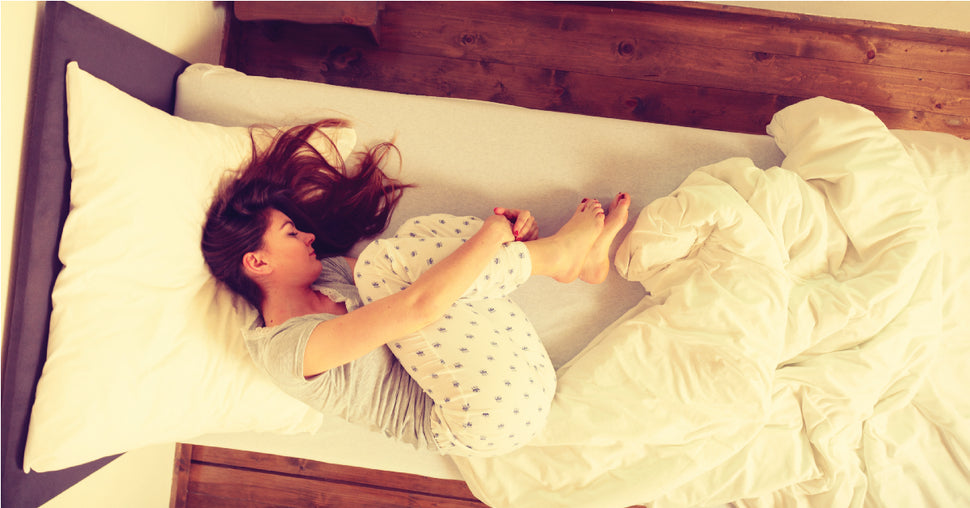Best Sleeping Positions For You
04 Nov 2020
Sleep is vital for human health and wellbeing, playing a crucial role in almost all bodily functions. This is why sleep deprivation and impaired sleep is linked to most health problems that we face today. That includes everything from obesity and weakened immunity to diabetes and depression.
When it comes to sleep, we tend to think solely in terms of time assigned to sleeping. However, the duration of quality sleep is impacted by more than the amount of time spent in bed. Your sleep position actually has a huge impact on sleep quality. This may sound surprising, but it shouldn’t be.
Sleep posture (which side to sleep) is known to directly affect and trigger conditions like sleep apnea, heartburn and GERD, and lower back pain. All of these conditions interfere with sleep quality, so addressing them with a change in sleeping position also reduces the risk of disturbed and poor-quality sleep.
Of course, it’s not easy to immediately adopt the correct sleeping position or change the one that you’ve favored most of your life, so don’t expect instant results. It takes time to retrain your body to sleep in a new position, but it’s well worth the effort.
What’s The Best Sleep Position For You?
There is no one-size-fits-all solution when it comes to sleep positions. Every sleeping position offers its own benefits and risks, but some are clearly better than others. The best sleeping position will therefore vary depending on your general health status and the health conditions that affect you. Here’s a list of sleeping positions to help you choose one that works best for you.
Sleeping On Your Back
To all the yogis out there who love the Savasana pose, sleeping on your back is the clear winner; it’s incredibly relaxing and easy on your body. This sleep position is also regarded as healthy by most experts and is often recommended for people who suffer from neck and spine problems.
Sleeping on the back keeps the spine straight and untwisted, with gravity working on your body to maintain an even spine alignment. This reduces any unnecessary pressure on the back and joints, while the mattress actually provides optimal spine support.
Back sleeping is also great for anyone trying to fight those annoying signs of aging – facial wrinkles. It will do you more good than using anti-aging creams as your face isn’t pressed into a pillow, which otherwise increases wrinkle formation (1).
Cons: The downside to sleeping on your back is that it can exacerbate sleep apnea or snoring. For some individuals it may also aggravate back pain, but this will depend on the type of back pain you’re dealing with.
Tip: Only use a single and preferably thin pillow beneath your head to keep your neck in a neutral position and allow unobstructed airflow. Try putting a pillow just below/behind your knees as this should help support the spine’s natural curvature.

Sleeping On Your Side
When we talk about healthy sleeping positions, we tend to overlook sleeping on the side. In fact, many people think that side sleeping is bad, but this is quite untrue. Sleeping on your side is particularly good for you if you suffer from sleep apnea as it instantly reduces or stops snoring.
A small study that was published in the American Journal of Gastroenterology found that individuals who slept on the left side were less likely to experience GERD symptoms as compared to those sleeping on the right side (2). This is most likely because of the location of the esophagus connection with the stomach. This makes sleeping on the left side one of the best sleeping positions for digestion.
Cons: Research shows that sleeping on your side is associated with an earlier onset of facial wrinkles (1). Sleeping on the side also increases pressure on a single arm and shoulder. This can impair circulation and increase pressure on the nerves in the region. Constriction of the neck and shoulder muscles is the most common problem associated with side sleeping, especially if you are overweight (3).
Tip: Place a pillow between your knees to help with hip alignment, lowering the risk of both lower back and knee pain.
Sleeping In The Fetal Position
Aside from the fact that the fetal position is comforting, especially when you’re sad or stressed, it can also be a healthy sleep position. It offers plenty of health benefits, especially during pregnancy and also if you suffer from lower back pain or sleep apnea.
The fetal or baby sleeping position, as some refer to it, is ideal during pregnancy as it reduces pressure on the back and improves circulation for both the mother and baby. As is the case with side sleeping, curling into the fetal position on the left side would also relieve GERD symptoms. The position may also provide relief to individuals with a herniated disk since it causes less bending towards the tail end of the spine.
Cons: The fetal position is no exception and it also has some downsides. Curling tightly into the fetal position can impair deep breathing and it may increase the risk of stiffness and joint pain. These risks can easily be countered if your sleep posture is loose and relaxed.
Tip: Don’t curl up too tight and keep a pillow between your knees. This will lower the risk of joint pain and breathing impairment.

Sleeping On Your Stomach
If you’re looking for the best way to sleep, you can bet that it’s not on your tummy. Lying on your tummy is regarded as the worst possible position to sleep in for various reasons. The only circumstance under which it helps to some extent is if you have sleep apnea or snoring (4). Beyond that benefit it just has a whole lot of cons.
Cons:
When you sleep on your stomach, the natural curve of the spine is flattened, which in itself can exacerbate neck and back pain. Additionally, much of the body’s weight gets pushed onto the core, increasing pressure on the spine, muscles, and joints. As a result, you’re more likely to experience back, muscle, and joint pain. When sleeping on your stomach, your face is buried into your pillow and invariably turned to one side. This causes unnecessary neck strain and you’re likely to experience a stiff neck or crick in the neck the following morning. As if all of this weren’t bad enough, it is also the worst sleeping position for facial wrinkles.
Tip: You should change your sleeping position right away, but until then try keeping a pillow just below your belly and pelvis to ease back pain.
The Takeaway
Considering that the average person is advised to sleep for 8 hours a day and lives to about 75 years, it’s safe to assume that you would spend about 25 years sleeping. That’s not wasted time, but it is if you’re not getting quality sleep. Correcting your sleeping position is one of the simplest and most inexpensive ways to improve sleep quality.
In addition to finding the best sleeping posture for yourself, you can also turn to melatonin supplements, which work as a natural sleep aid. Adopt other sleep hygiene practices, such as having your last meal at least three hours before bedtime, turning off all digital screens an hour before bedtime, using blackout curtains to keep the bedroom dark, and so on.
Keep in mind that you could experience sleep impairment without even realizing it. Just because you get uninterrupted sleep it doesn’t mean that you’re sleeping well. After a good night’s sleep, you should wake up feeling refreshed and energized.
FAQs
1. Is sleeping on the side bad?
Sleeping on the side is actually considered healthy for most people, but can increase shoulder and neck stiffness, especially if you are overweight.
2. What is the best position to sleep – left or right?
Sleeping on the left side is regarded as the healthier choice as it is known to lower the risk of GERD symptoms, while sleeping on the right side has the opposite effect.
3. Is sleeping on your stomach bad?
Yes, sleeping on the stomach is regarded as bad because it puts greater pressure on the spine, muscles, and joints.
4. Is 2 hours of sleep enough?
No, 2 hours of sleep is nowhere near enough. The average adult is advised to get at least 7 to 8 hours of uninterrupted sleep each night.
5. Is it healthier to sleep naked?
It is advisable to be as comfortable as possible to get restful sleep, so sleeping naked is healthier, especially if your nightwear is restrictive.
6. Is it OK to sleep without a pillow?
The decision to sleep with or without a pillow is dependent on several factors and on the sleep position. For example, sleeping on your tummy without a pillow improve spine alignment, but can have the opposite effect when sleeping on the side.
7. Is sleeping on your left side bad for your heart?
Despite what you may have heard, sleeping on your left side is actually considered good for the heart as it reduces pressure on blood vessels that carry blood to the heart, thereby improving blood flow.
Recommended Reads:
Sleep – An Easy Way To Manage Weight
Can’t Sleep? Blame it On Your Genes!
Here’s How To Turn Off Your Thoughts At Night
5 Quick recipes that will help you sleep better (Trust Us!)
THIS Is Why You Should Not Hit The Snooze Button In The Morning!
Skin: Renew - Glutathione - Orange Flavour
- ₹1,996
- ₹1,996
-
₹2,600 - ( 23% OFF)
Categories
- Choosing a selection results in a full page refresh.
- Press the space key then arrow keys to make a selection.
this is the sidecart












